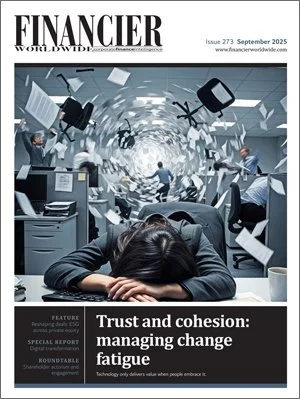Shifting legal landscape as digital assets mature
September 2025 | FEATURE | FINANCE & INVESTMENT
Financier Worldwide Magazine
The rapid evolution of digital assets continues to reshape the global legal landscape, presenting both challenges and opportunities for regulators, courts and market participants.
As digital assets – including cryptocurrencies, stablecoins, tokenised securities and central bank digital currencies – have matured, regulators around the world have begun to shift from reactive and fragmented approaches to more structured and comprehensive legal frameworks. This shift reflects not only the growing economic significance of digital assets but also the increasing complexity of the risks that companies must now manage. The pace of innovation in this space has outstripped traditional regulatory mechanisms, prompting urgent calls for harmonised standards and cross-border cooperation. As a result, legal systems are being tested in their ability to adapt to decentralised technologies and novel financial instruments.
Recent years have seen a range of developments, from disputes involving tokenised assets and smart contract enforcement to insolvencies within the crypto industry and the emergence of new regulatory frameworks.
How the world is regulating digital assets
Efforts are underway across multiple jurisdictions to strengthen digital asset regulation. In several major markets, regulators are formalising bespoke regimes to address concerns such as market integrity, financial crime, investor protection and systemic risk.
In the European Union, the Markets in Crypto-Assets (MiCA) regulation, effective from 2024, represents one of the most comprehensive frameworks to date. It introduces licensing requirements for cryptoasset service providers and disclosure standards for issuers. MiCA also aims to reduce regulatory arbitrage by ensuring consistent rules across member states, thereby enhancing legal certainty for businesses operating in multiple EU countries.
The UK is also advancing phased legislation that distinguishes between stablecoins, security tokens and unregulated cryptoassets. On 29 April 2025, HM Treasury published near-final draft legislation establishing a financial services regulatory regime for cryptoassets, accompanied by a policy note outlining the intended outcomes. This legislation builds on proposals from HM Treasury’s October 2023 paper and marks a significant step in bringing cryptoassets within the UK’s financial regulatory perimeter.
“The digital asset sector is entering a transformative phase, and companies must prioritise compliance to remain competitive and secure.”
The draft legislation introduces regulated activities under the Financial Services and Markets Act 2000 (Regulated Activities) Order 2001, including the issuance of UK stablecoins, custody arrangements, platform operations and transaction facilitation in “qualifying cryptoassets”. Firms undertaking these activities will require authorisation and oversight by the Financial Conduct Authority. However, for “qualifying stablecoins”, the regime applies only to UK issuers. The approach mirrors the existing UK regulatory framework for traditional financial services and aligns with MiCA in adapting regulated activities for cryptoassets.
In the US, the regulatory outlook remains more complex. Historically, the absence of federal clarity has led to tensions between the Securities and Exchange Commission (SEC), the Commodity Futures Trading Commission (CFTC) and state agencies. However, recent developments suggest a move toward greater transparency. On 5 May 2025, several House committees introduced a discussion draft for a bill to establish a regulatory framework for digital assets. On 29 May, French Hill, chairman of the House Financial Services Committee, introduced the Digital Asset Market Clarity Act, which positions the CFTC at the centre of digital asset regulation. This coincides with the Senate’s consideration of the Guiding and Establishing National Innovation for US Stablecoins (GENIUS) Act of 2025, which proposes a regulatory framework for stablecoins.
The Clarity Act outlines a foundational structure for digital asset regulation. It categorises digital assets into securities, commodities and stablecoins, and grants the CFTC exclusive jurisdiction over digital commodities, including exchanges, brokers and dealers – except where these are transacted by SEC-registered entities. The Act also introduces enforcement authority and anti-fraud provisions, requiring broker-dealers to establish business conduct standards. It defines a “mature blockchain system” as one not controlled by any individual or group under common control. Once certified as mature, digital assets relying on such systems may be exempt from certain disclosure requirements. Furthermore, the Act promotes federal pre-emption of state regulation of digital commodities and explicitly includes digital commodity exchanges, brokers and dealers within the scope of the Bank Secrecy Act.
What lies ahead: the next chapter in digital asset regulation
The regulation of digital assets across major jurisdictions remains a complex and evolving area. While considerable progress has been made, further work is needed to ensure that regulatory frameworks are robust, comprehensive and capable of fostering innovation while safeguarding consumers. Although some measures, such as the Clarity Act, are still in draft form and subject to further debate and amendment, the overall direction is clear. The digital asset sector is entering a transformative phase, and companies must prioritise compliance to remain competitive and secure.
In this environment, proactive engagement with regulators, legal counsel and industry bodies will be essential. Firms that invest early in understanding and adapting to these changes are likely to gain a strategic advantage as the regulatory landscape continues to mature.
© Financier Worldwide
BY
Richard Summerfield


